While Maryland has many resident birds that can be seen all year, others only make their home in the state for part of the year. Some birds just spend their summer breeding season in Maryland, then in autumn migrate back down south for the winter. However, for other birds that breed further north, Maryland is their southern winter home! Many shorebirds also make Maryland’s Chesapeake Bay region and Atlantic Ocean coast their winter home.
For most of these species, migration into Maryland is a reliable annual event. However, others are irruptive migrators whose movements vary based on food availability. For those species, irruptions into Maryland vary from year to year in both range and numbers.
Here are 29 birds that usually call Maryland home only during the winter months, and where and when you can expect to see them.
1. American Coot (Fulica americana)
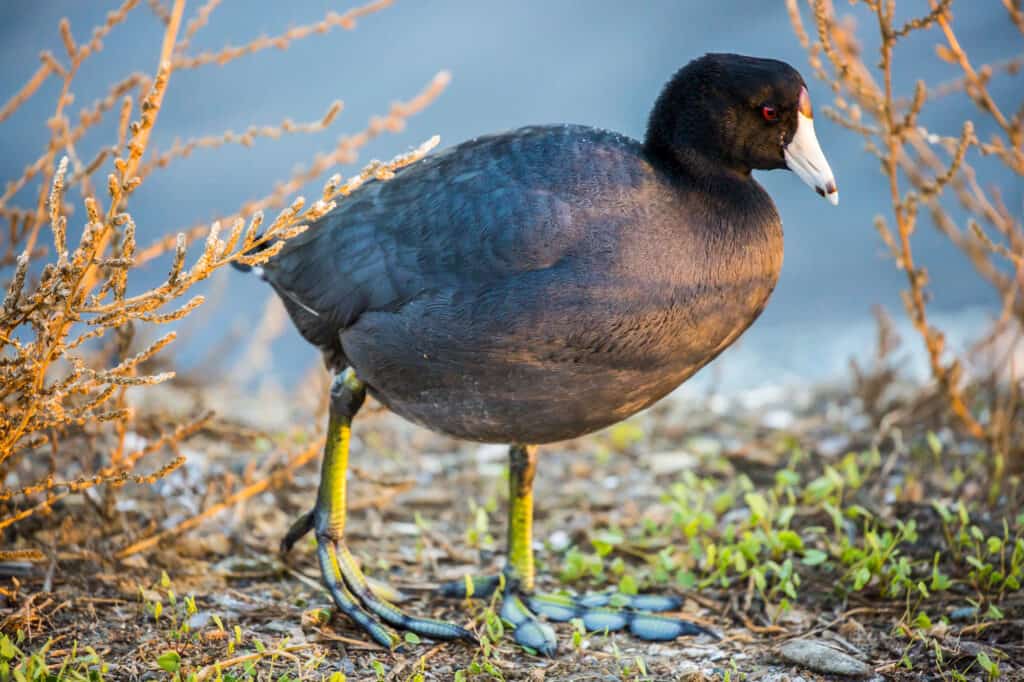
The American coot measures 13 – 16 in (33 – 40 cm) in length.
©yhelfman/Shutterstock.com
The American coot migrates across the state in autumn but only overwinters in open waters in the greater Chesapeake Bay region.
2. Black-Bellied Plover (Pluvialis squatarola)

The black-bellied plover measures 11 – 12 in (28 – 30 cm) in length.
©Elliotte Rusty Harold/Shutterstock.com
The black-bellied plover migrates across the state in autumn but only overwinters in the coastal areas.
3. Bufflehead (Bucephala albeola)
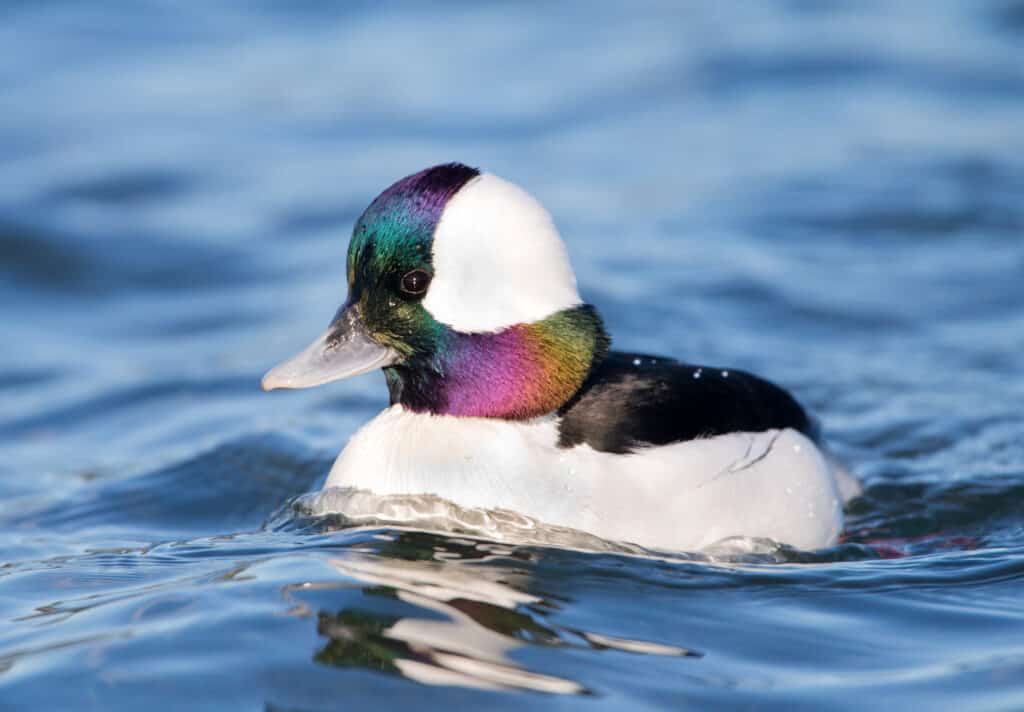
The bufflehead measures 13 – 15 in (33 – 38 cm) in length.
©Birdiegal/Shutterstock.com
The bufflehead overwinters in ponds, lakes, and rivers across all but the extreme northwest corner of the state.
4. Canvasback (Aythya valisineria)

The canvasback measures 20.5 in (52 cm) in length.
©Wirestock/iStock via Getty Images
The canvasback migrates across the state in autumn but only overwinters in ponds, lakes, and rivers in the eastern half of the state.
5. Common Loon (Gavia immer)
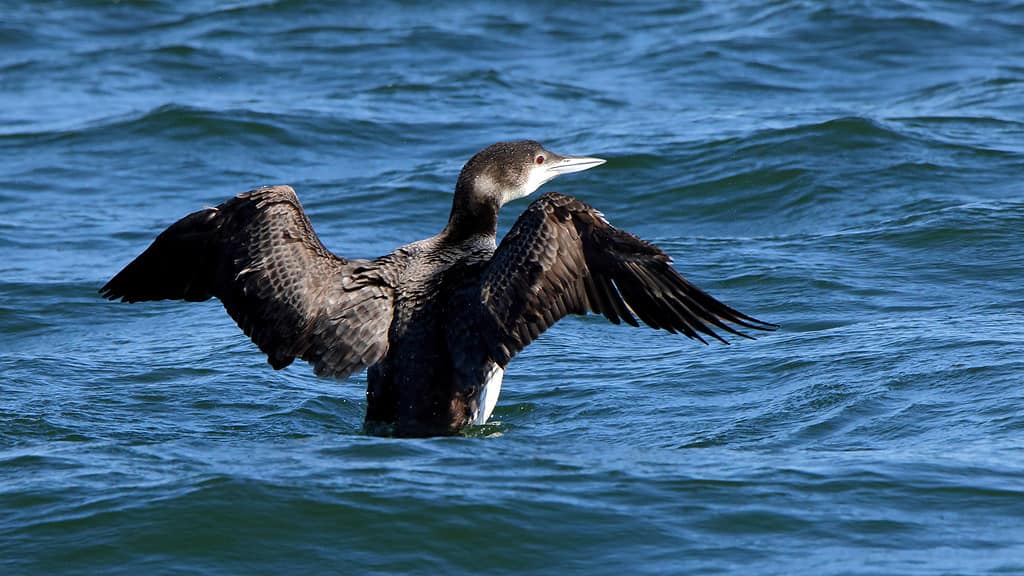
The
common loon
measures 28 – 36 in (71 – 91 cm) in length.
©John_Wijsman/iStock via Getty Images
The common loon migrates across the state in autumn but only overwinters in the coastal areas.
6. Common Merganser (Mergus merganser)

The common merganser measures 26 – 28 in (66 – 71 cm) in length.
©jamesvancouver/iStock via Getty Images
The common merganser overwinters in open water, especially large rivers, across the state.
7. Dunlin (Calidris alpina)

The dunlin measures 8 -9 in (20 -23 cm) in length.
©Simonas Minkevicius/Shutterstock.com
The dunlin overwinters in the greater Chesapeake Bay region.
8. Evening Grosbeak (Coccothraustes vespertinus)
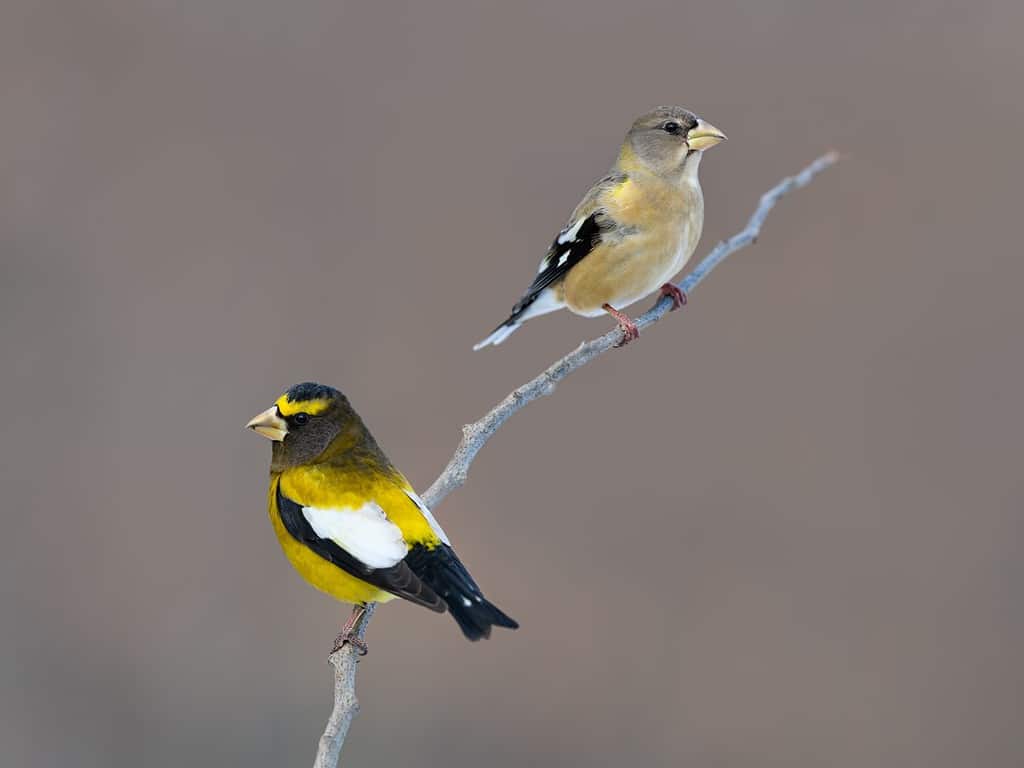
The evening grosbeak measures 8 in (20 cm) in length.
©FotoRequest/Shutterstock.com
The evening grosbeak is an irruptive migrator that may invade the state during the winter. It will also visit seed feeders.
9. Greater Yellowlegs (Tringa melanoleuca)
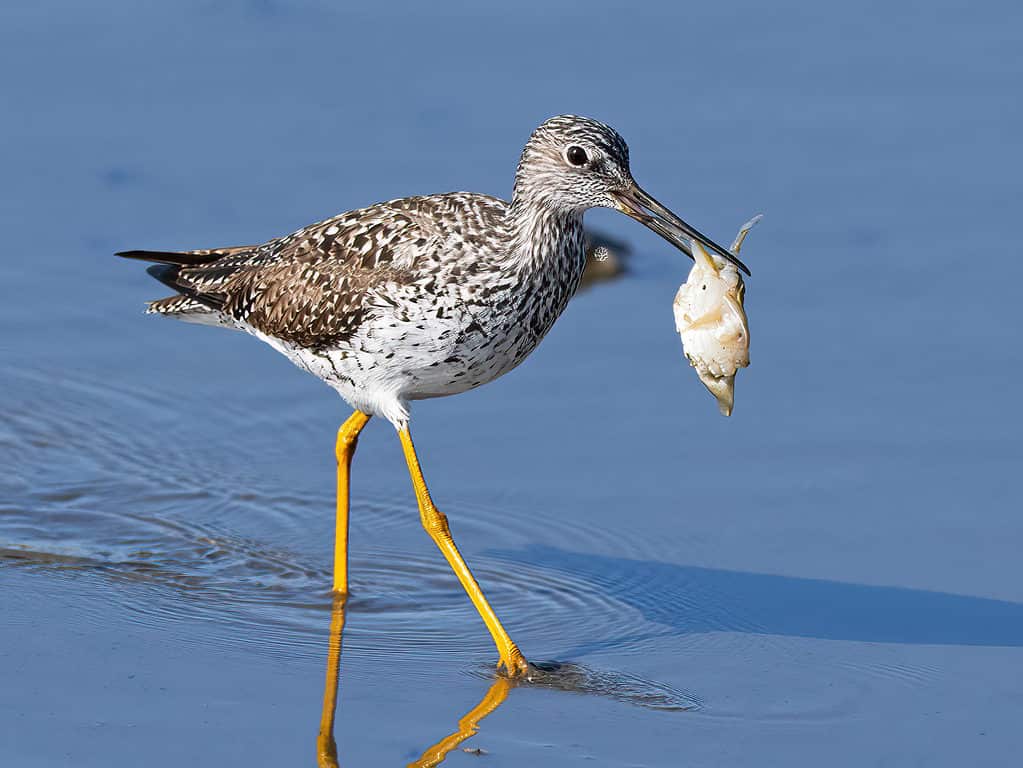
The greater yellowlegs measures 13- 15 in (33 – 38 cm) in length.
©iStock.com/BrianEKushner
The greater yellowlegs overwinters in the state’s coastal areas.
10. Green-Winged Teal (Anas carolinensis)
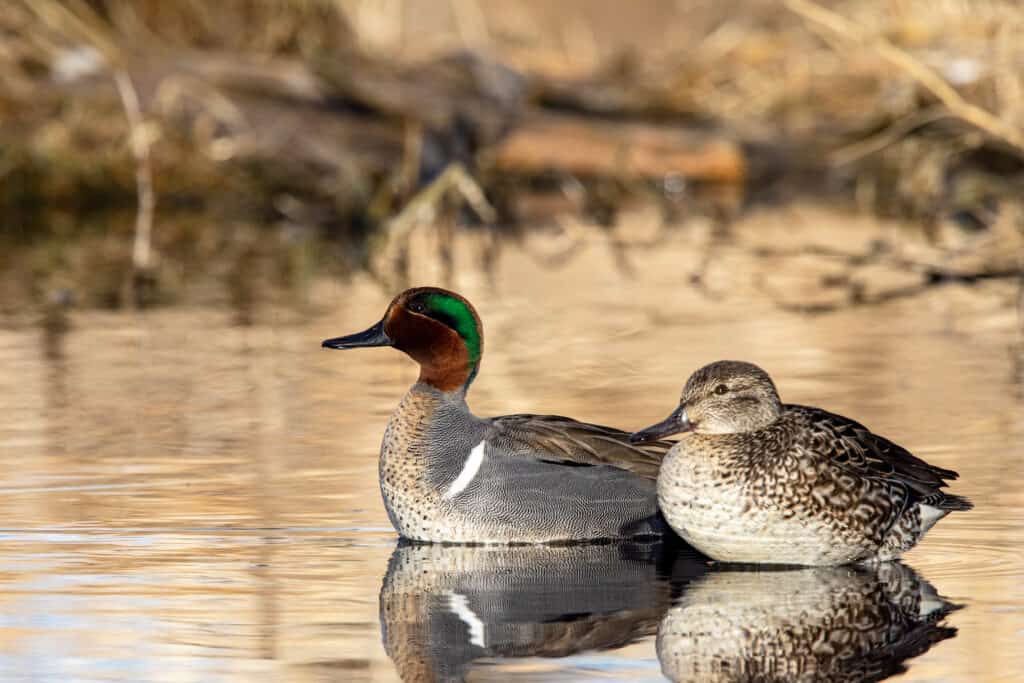
The green-winged teal measures 14 – 15 in (36 – 38 cm) in length.
©J Edwards Photography/Shutterstock.com
The green-winged teal migrates across the state in autumn but only overwinters in shallow wetlands and coastal marshes in the eastern half of the state.
11. Lesser Scaup (Aythya affinis)

The lesser scaup measures 16 – 17 in (40 – 43 cm) in length.
©ps50ace/iStock via Getty Images
The lesser scaup migrates across the state in autumn but only overwinters in lakes, ponds, and coastal waters in the eastern half of the state.
12. Marbled Godwit (Limosa fedoa)

The marbled godwit measures 18 in (45 cm) in length.
©passion4nature/iStock via Getty Images
The marbled godwit can be seen across all but the westernmost region of the state during autumn migration but only overwinters in the coastal areas.
13. Northern Pintail (Anas acuta)
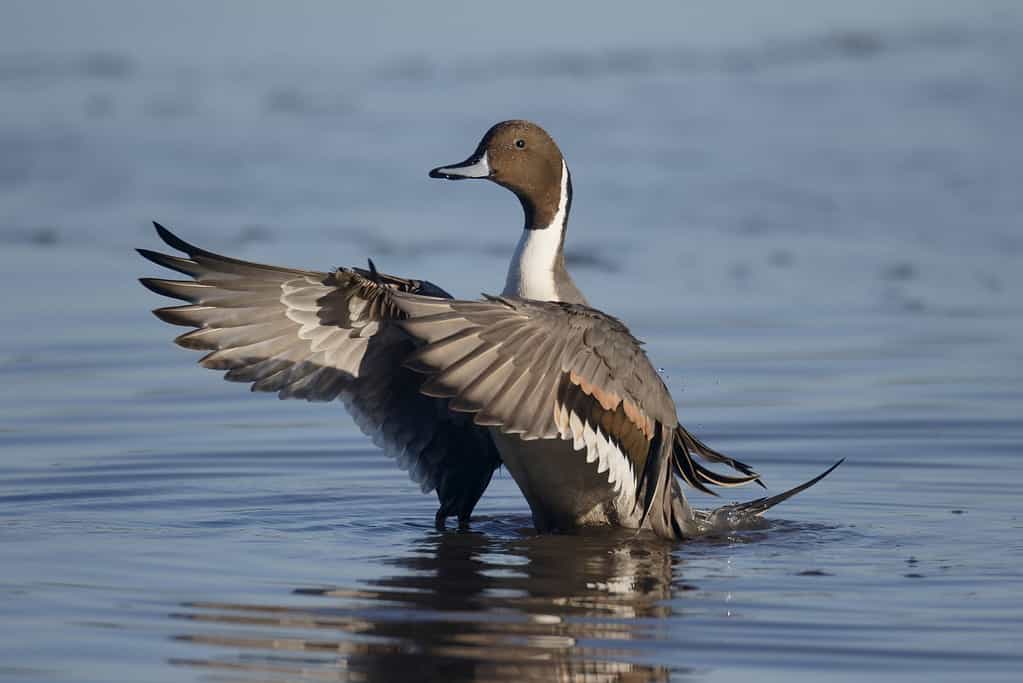
The northern pintail female measures 20 in (52 cm) and the male measures 25 in (63 cm) in length.
©MikeLane45/iStock via Getty Images
The northern pintail migrates across the state in autumn but only overwinters in the greater Chesapeake Bay region.
14. Northern Shoveler (Spatula clypeata)
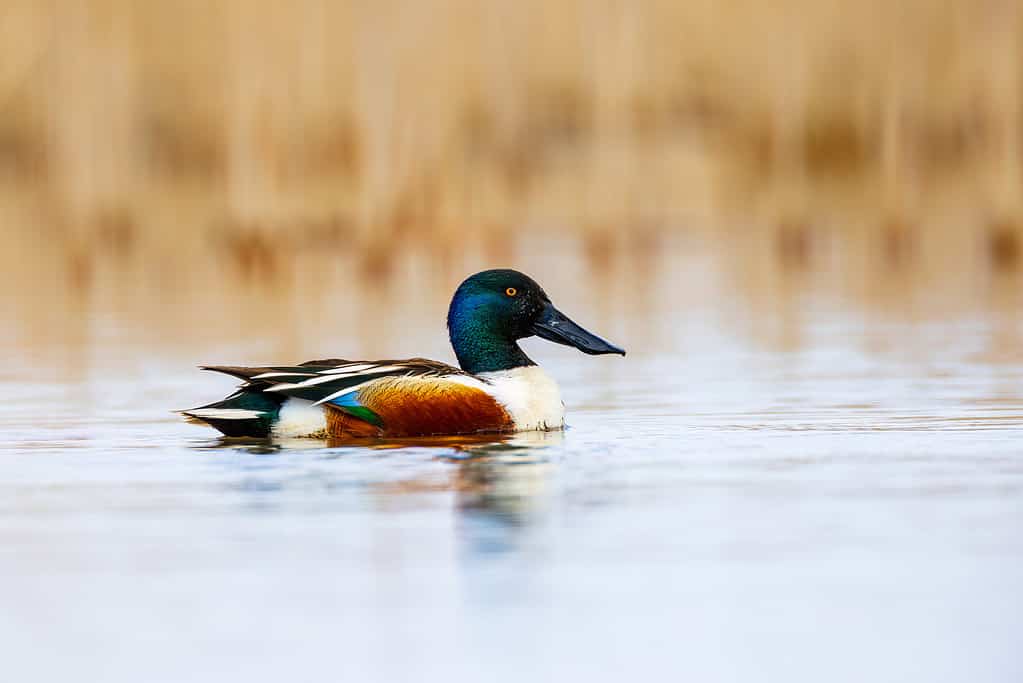
The northern shoveler measures 19 – 21 in (48 – 53 cm) in length.
©Eric Santin/iStock via Getty Images
The northern shoveler migrates across the state in autumn but only overwinters in ponds, small lakes, and shallow wetlands in the greater Chesapeake Bay region.
15. Palm Warbler (Setophaga palmarum)

The palm warbler measures 5.5 in (14 cm) in length.
©iStock.com/GummyBone
The palm warbler migrates across the state in autumn but only overwinters in the southeastern corner of the state.
16. Pine Siskin (Spinus pinus)
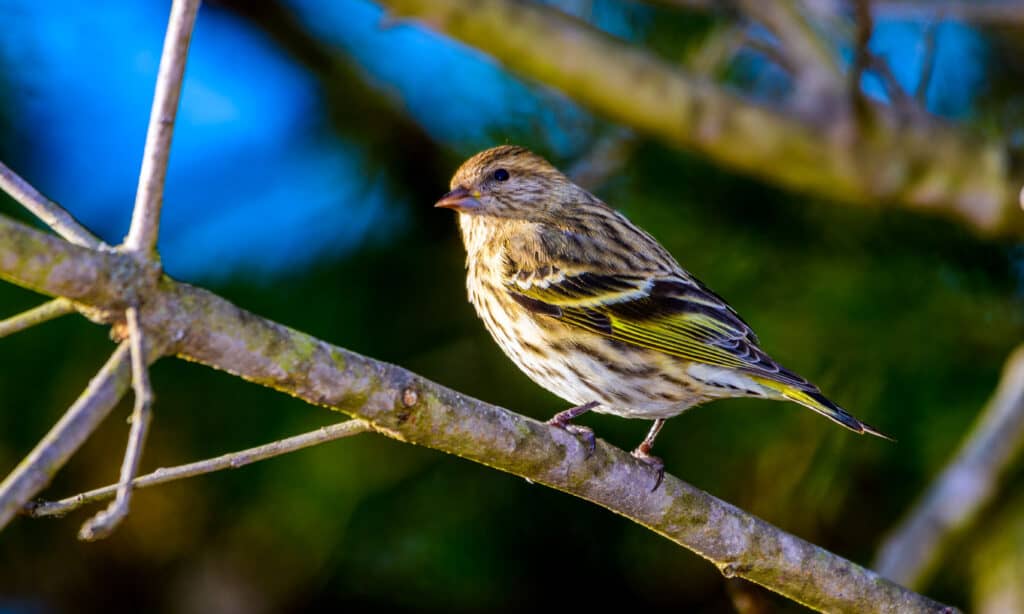
The pine siskin measures 5 in (13 cm) in length.
©Jeff W. Jarrett/Shutterstock.com
The pine siskin is an irruptive migrator that in heavy invasion years can be found across the state during the winter. It will also visit seed feeders.
17. Redhead (Aythya americana)
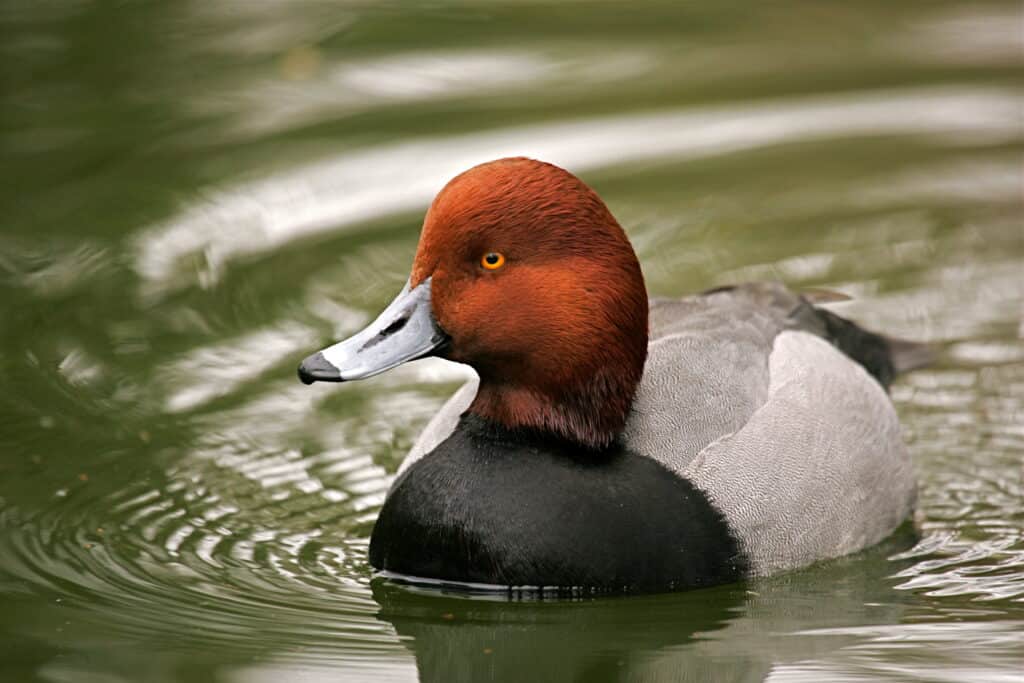
The redhead measures 19 in (48 cm) in length.
©Tom Reichner/Shutterstock.com
The redhead migrates across the state in autumn but only overwinters in large bodies of water in the greater Chesapeake Bay region.
18. Ring-Billed Gull (Larus delawarensis)
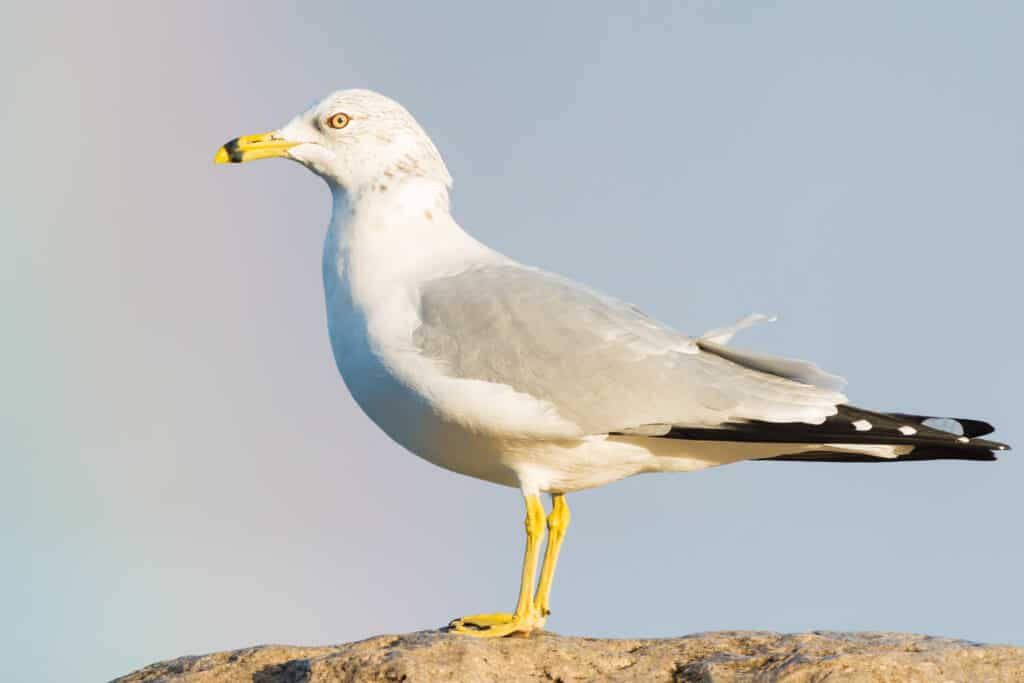
The ring-billed gull measures 18 – 20 in (45 – 51 cm) with up to a 4 ft (1.2 m) wingspan.
©iStock.com/PaulReevesPhotography
The ring-billed gull migrates across the state in autumn but only overwinters in the greater Chesapeake Bay region.
19. Ring-Necked Duck (Aythya collaris)

The ring-necked duck measures 16 – 19 in (41 – 48 cm) in length.
©Jeff Edwards/iStock via Getty Images
The ring-necked duck migrates across the state in autumn but only overwinters in the eastern half of the state, most commonly in larger lakes.
20. Ruby-Crowned Kinglet (Corthylio calendula)

The ruby-crowned kinglet measures 4 in (10 cm) in length.
©iStock.com/mirceax
The ruby-crowned kinglet migrates across the state in autumn but only overwinters in the greater Chesapeake Bay region.
21. Ruddy Turnstone (Arenaria interpres)

The ruddy turnstone measures 9.5 in (24 cm) in length.
©Michael Potter11/Shutterstock.com
The ruddy turnstone overwinters in the state’s coastal areas.
22. Sanderling (Calidris alba)

The sanderling measures 8 in (20 cm) in length.
©Bouke Atema/Shutterstock.com
The sanderling overwinters in the state’s coastal areas.
23. Semipalmated Plover (Charadrius semipalmatus)

The semipalmated plover measures 7 in (18 cm) in length.
©Dee Carpenter Originals/Shutterstock.com
The semipalmated plover migrates across the state in autumn but only overwinters in the coastal areas, primarily along the Atlantic coast.
24. Short-Billed Dowitcher (Limnodromus griseus)
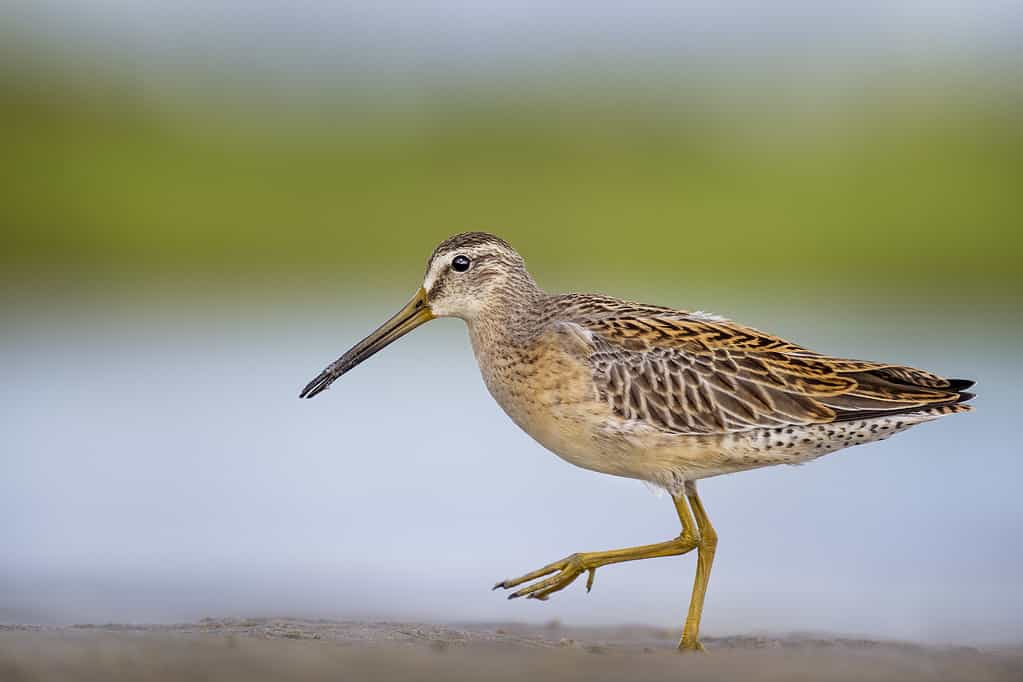
The short-billed dowitcher measures 11 in (28 cm) in length.
©ps50ace/iStock via Getty Images
The short-billed dowitcher overwinters in the state’s coastal areas.
25. Snow Goose (Anser caerulescens)

The snow goose measures 25 – 38 in (64 – 97 cm) with up to a 4.5 ft (1.4 m) wingspan.
©ps50ace/iStock via Getty Images
The snow goose migrates across the state in autumn but only overwinters in the greater Chesapeake Bay region.
26. Tundra Swan (Cygnus columbianus)

The tundra swan measures 50 – 54 in (127 – 137 cm) in length with up to a 5.5 ft (1.7 m) wingspan.
©hay_mn97/Shutterstock.com
The tundra swan overwinters in open bodies of water in all but the westernmost region of the state.
27. Western Sandpiper (Calidris mauri)

The western sandpiper measures 6.5 in (16 cm) in length.
©Stephen Bonk/iStock via Getty Images
The western sandpiper overwinters in the state’s coastal areas.
28. White-Throated Sparrow (Zonotrichia albicollis)

The white-throated sparrow measures 6 – 7 in (15 – 18 cm) in length.
©Fiona M. Donnelly/Shutterstock.com
The white-throated sparrow overwinters across the state. It will also visit ground feeders.
29. Yellow-Rumped Warbler (Setophaga coronata)
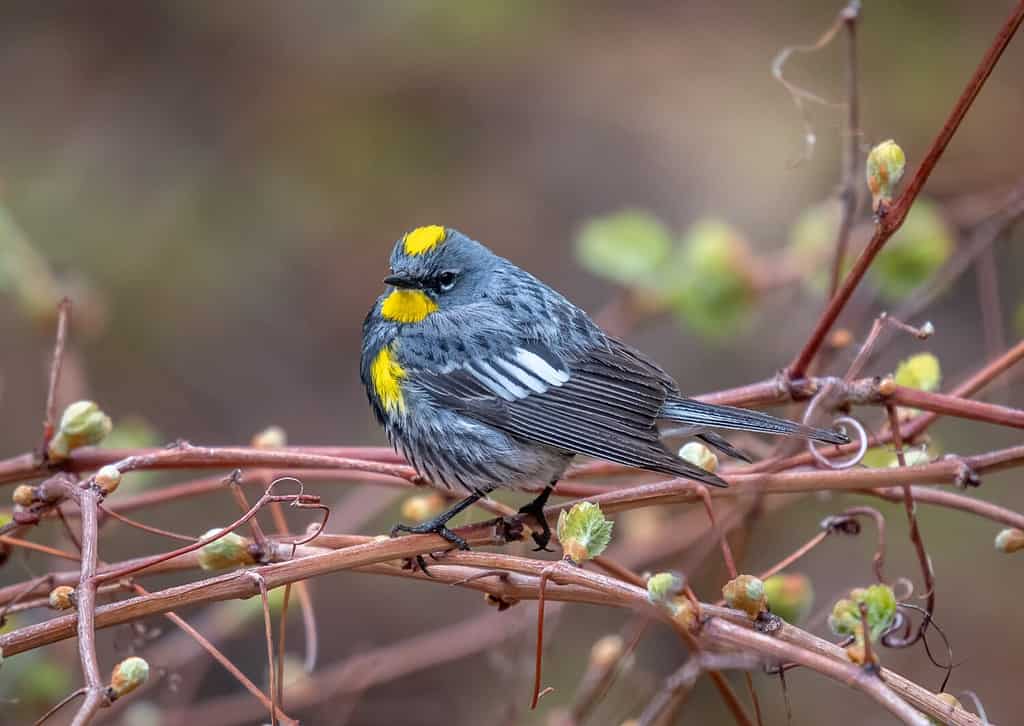
The yellow-rumped warbler measures 5 – 6 in (13 – 15 cm) long.
©Gerald A. DeBoer/Shutterstock.com
The yellow-rumped warbler overwinters in all but the westernmost region of the state. It is more common along the coast.
Summary of 29 Birds That Spend Their Winters in Maryland
| Species | Where Found in Winter |
|---|---|
| 1. American Coot (Fulica americana) | greater Chesapeake Bay region |
| 2. Black-Bellied Plover (Pluvialis squatarola) | coastal areas |
| 3. Bufflehead (Bucephala albeola) | statewide except extreme NW corner |
| 4. Canvasback (Aythya valisineria) | E half of state |
| 5. Common Loon (Gavia immer) | coastal areas |
| 6. Common Merganser (Mergus merganser) | statewide |
| 7. Dunlin (Calidris alpina) | greater Chesapeake Bay region |
| 8. Evening Grosbeak (Coccothraustes vespertinus) | statewide during irruptive migrations |
| 9. Greater Yellowlegs (Tringa melanoleuca) | coastal areas |
| 10. Green-Winged Teal (Anas carolinensis) | E half of state |
| 11. Lesser Scaup (Aythya affinis) | E half of state |
| 12. Marbled Godwit (Limosa fedoa) | coastal areas |
| 13. Northern Pintail (Anas acuta) | greater Chesapeake Bay region |
| 14. Northern Shoveler (Spatula clypeata) | greater Chesapeake Bay region |
| 15. Palm Warbler (Setophaga palmarum) | SE corner of state |
| 16. Pine Siskin (Spinus pinus) | statewide during irruptive migrations |
| 17. Redhead (Aythya americana) | greater Chesapeake Bay region |
| 18. Ring-Billed Gull (Larus delawarensis) | greater Chesapeake Bay region |
| 19. Ring-Necked Duck (Aythya collaris) | E half of state |
| 20. Ruby-Crowned Kinglet (Corthylio calendula) | greater Chesapeake Bay region |
| 21. Ruddy Turnstone (Arenaria interpres) | coastal areas |
| 22. Sanderling (Calidris alba) | coastal areas |
| 23. Semipalmated Plover (Charadrius semipalmatus) | coastal areas; primarily Atlantic coast |
| 24. Short-Billed Dowitcher (Limnodromus griseus) | coastal areas |
| 25. Snow Goose (Anser caerulescens) | greater Chesapeake Bay region |
| 26. Tundra Swan (Cygnus columbianus) | statewide except far W region |
| 27. Western Sandpiper (Calidris mauri) | coastal areas |
| 28. White-Throated Sparrow (Zonotrichia albicollis) | statewide |
| 29. Yellow-Rumped Warbler (Setophaga coronata) | statewide except far W region; more common in coastal areas |
The photo featured at the top of this post is © Mircea Costina/Shutterstock.com
Thank you for reading! Have some feedback for us? Contact the AZ Animals editorial team.






